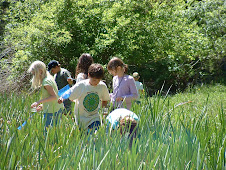
The Mountain Park has been receiving a lot of snow lately and the kids absolutely love it. Although there are a few days where the schools will opt out of participating in the days session due to weather conditions, most schools and classes do not stop when we get a good snow.
If the snow is deep enough the students don snow-boots and it's class as usual . . . although it's quite a different day from one spent indoors sitting at a desk. These students hike through out the snowy forests and get all of their days worth of educational standards by using the various aspects of nature as teaching opportunities.
One of the focuses for this month is the biology and identification of the trees in the Mountain Park. There are six prominent types of coniferous trees in the park, two Junipers, two Pines and two Fir. Although there are many differences between the different trees, the students are taught to focus on a few easy to discern traits such as the type of leaf (needles or scales) and their arrangement.

For example, the
Douglas Fir [
left] has very green needles that grow from the branch in all directions (like the spokes on Douglas' bicycle wheel!) . .

while the
White Fir [
right] has slightly bluish-green needles which are almost twice as long and typically grow from the sides of the branch and curve upwards.
It's also a great opportunity to begin to prepare them for next sessions focus which is on Mammals and Tracking by pointing out the occasional signs and quite frequent tracks of the various animals which make the Mountain Park their habitat.
Often we find the tracks of mule deer and fox and at times we have even come across tracks of wild cats such as the bobcat that we saw and got
photographs and even a little
video of last year. Of course various animal scat, especially from the many deer that visit the park, is quite prevalent and provides not only some frequent laughter from the students but also a lot of opportunities to segue into many on-topic conversations.
We also find signs of squirrel activity; the

ponderosa branch tips on the ground around the drip-line of the trees, some of which have been stripped of their needles and bark due to the squirrels eating the sugary inner bark.
~Ranger David "Pine" Martin
Environmental Educator
Mountain Park Environmental Center














